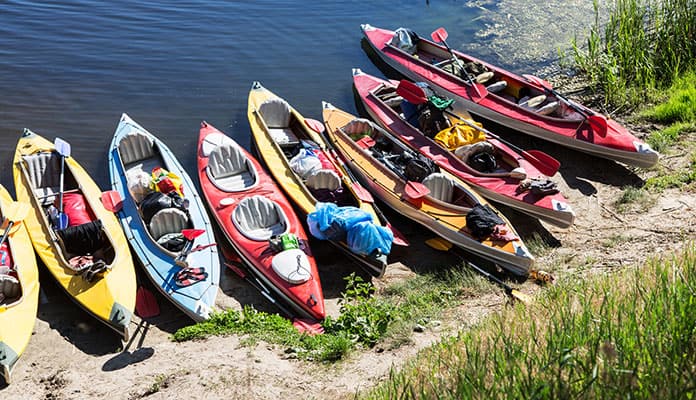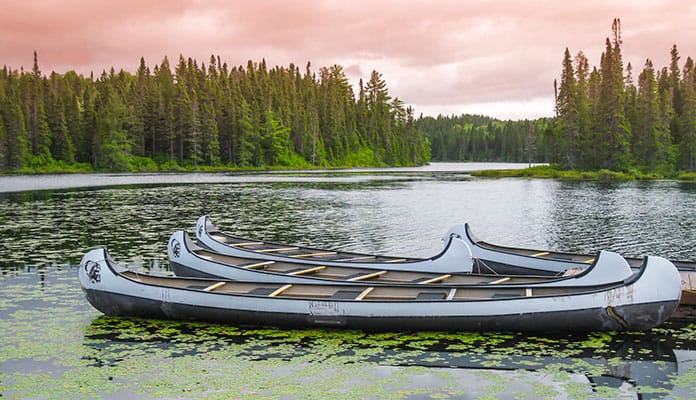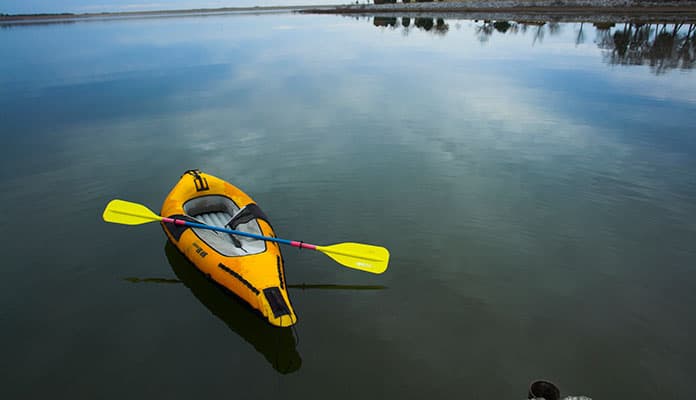
Want to start a row in your local marina? Get some paddlers together in a room and ask, “Which is better: a kayak or a canoe?”
And then take cover.
If you are a first-time paddler, you may be wondering what this canoe vs. kayak fuss is all about. After all, they’re both small boats and they both need to be paddled to move; and both fishing kayaks and canoes can be used for fishing or traveling over the water. So what’s all the argument about?
For people who don’t know much about paddling, a kayak, and a canoe is pretty much the same. However, if you look closely, you will see that both boats possess key features and fundamental differences, which make each of them distinctly unique. In this article, we’ll take a closer look at those features and differences, as well as some of the pros and cons of each boat. Hopefully, by the time you finished reading this article, you will be able to compare a kayak vs canoe and have a better idea about which boat is most suitable for you should you decide to invest your time and money into paddling.
The History of the Kayak and the Canoe
Both the kayak and the canoe have been around for thousands of years. However, where they originated and the purpose for which they were built were very different from each other.
History of the Kayak
Accordingly, the kayak was invented by the Inuit, an indigenous group of people living near the arctic regions. Other indigenous groups like the Aleut, Yupik, and Ainu were known to use kayaks as well. As small, lightweight, and quiet boats, kayaks were primarily used for fishing and hunting in inland waterways and were very effective for sneaking up on seals.
The designs of the kayak used then varied from one region to another. In general, though, the kayaks of old were made by hand, using whatever wood is available for the frame and sealskin for the covering. Some experts also believed that these people used carved whale bones for the frame since trees were scarce in those places.
History of the Canoe
It can be difficult to pinpoint exactly where the canoe originated from. Researchers have found evidence of canoes being used in Africa and China as far back as 8,000 years ago. However, the oldest canoe (and consequently the oldest boat) ever found was the Pesse Canoe, discovered in Pesse in The Netherlands and was said to be 10,000 years old.
Unlike ancient kayaks, ancient canoes were made from whole tree trunks or logs. The natives who made these dugout canoes used axes or whatever tools they had to carve and hollow out the middle areas of the log.
There were also canoes discovered in North America, though they were very different in design. Instead of hollowed-out tree trunks, the canoes of North America made use of wooden frames and were covered in birch bark, which was held together by sticky tree resin.
Ancient canoes were also used differently. Whereas ancient kayaks were used predominantly used for fishing and hunting, ancient canoes were mainly used as a mode of transportation and for moving or carrying goods.
Kayak and Canoe Design

To the untrained eye, a kayak and a canoe will look remarkably the same, especially when you’re comparing sit-on-top kayaks with regular canoes. But if you look closely, there is a remarkable difference between a kayak vs canoe.
Kayak Design
In general, kayaks have a narrow and streamlined design, which allows them to be faster and more agile than canoes. In a kayak, paddlers are seated at the bottom of the boat with their legs stretched out in front of them. Paddlers use double-blade kayak paddles, which improves their paddling efficiency and speed.
There are several types of kayaks, but they can all be categorized under two basic styles: the sit-inside kayaks (SINK) and the sit-on-top (SOT) kayaks. Both SINKs and SOTs are available in singles or doubles, and as hard shells, and as inflatables.
Sit-Inside Kayaks (SINKs) are more traditional-looking than sit-on-top kayaks and are what most people think of when talking about kayaks. SINKs are closed-deck, and paddlers enter and sit in the kayak via the cockpit, with their stretched-out legs under the front deck. Under the front deck are footpegs, which can be adjusted according to the paddler’s leg length. Around the cockpit is the cockpit rim where paddlers can attach a kayak spray skirt to prevent the water from coming in. SINKs also have waterproof compartments (accessible through the hatches on the deck) where paddlers can keep their things. Some paddlers may not like the design of sit-inside kayaks because it limits their movement. However, some SINKs sport larger cockpits to prevent paddlers from feeling ‘confined.’
Sit-on-Top Kayaks (SOTs) were initially developed for leisure paddling and exploring flat, calm waters. However, they were improved upon over time, and now they make the perfect type of kayak for fishing and even diving. Unlike sit-inside kayaks, sit-on-top kayaks do not have a cockpit. Instead, it features a molded top for the paddler to sit on, hence the name. There are aftermarket kayak seats available, which can be attached to the molded seat to make them more comfortable. SOTs also have small drain holes called ‘scupper holes’ which help to drain any water that may come inside the kayak. Yes, water can come inside SOTs because of the open-deck design, so you are can’t be sure that you’re not going to get wet when you use one.
Under SINKs and SOTs, we have the following group of kayaks:
Recreational Kayaks: These kayak designs are mostly used to paddle on calm, flat waters such as sheltered coastal areas, slow-moving rivers, lakes, and canals. Most recreational kayaks are between 9 to 12 feet long, easy to control, relatively comfortable, stable, and almost impossible to flip over.
White Water Kayaks: Unlike recreational kayaks, these are wider and shorter, which helps them to be more responsive and maintain buoyancy when maneuvering whitewater. Whitewater kayaks vary in length based on the activities they are involved in. The common types are river runners that are up to 9 feet long and playboats that are as short as 5 feet.
Touring and Ocean Kayaks: Often, these types of kayaks are much slimmer, longer, and are designed to paddle further distances much faster than recreational kayaks. Most are usually between 12 and 18 feet long and come with a luggage compartment both at the front and behind the kayak. Touring and ocean kayaks also contain rudders or skews to enable easier steering.
Inflatable kayaks: These are less durable than the rest of the kayaks but still give paddlers maximum fun. An inflatable kayak works the same way as a Sit on Top but is much portable. Most designs under this category can accommodate two people. Inflatable kayaks take the open form of canoes but are propelled using a double paddle.
Racing Kayaks: A racing kayak is slender, long, and made of lightweight material. These designs can accommodate up to four people and can be up to 36 feet long based on the number of paddlers in them. Racing kayaks often come with a rudder to assist with direction and sit lower in the waters than the rest of the kayaks. They are commonly used in marathons and sprints especially on flat waters.
Canoe Design
Canoes are generally larger and heavier than kayaks. They have an open-deck design so you can see the inside of the boat. Canoes usually have bench-like seats (usually two or more) for the paddler to sit on. Unlike kayaks, the canoe seat is elevated from the floor, which means that they have more freedom of movement. With a canoe, paddlers use a single-blade paddle, which is more challenging to paddle than double-bladed kayak paddles. Also, canoers can either seat on the benches or take a kneeling position when paddling. Canoers often prefer the kneeling stance because this allows them to generate more power behind their paddle strokes. Like kayaks, canoes also come in different types.
Recreational canoes are the most common type of canoe. Because they were designed for leisure paddling for one or more people, recreational canoes are naturally stable, steady, and easy to control. These types of canoes are perfect for paddlers who frequent slow-moving rivers and lakes.
Whitewater canoes are shorter than recreational canoes and have flotation panels in the front and back which helps them deal with water entering the canoe. Because of their shorter length, they are much less stable on the water, but it also makes them easier to maneuver. Unlike recreational canoes, whitewater canoes are designed to carry one or two people on fast-moving waters.
Racing canoes, as the name suggests, are predominantly used for solo or duo canoe racing. These types of canoes have a narrower body and sit lower in the water than recreational canoes. Most paddlers using racing canoes adopt a kneeling position when paddling as this stance helps them achieve optimal stroke power and speed.
You Might Also Be Interested In:
Cockpit
Kayaks: A kayak often takes a “closed” form and comes with a cockpit where the paddler sits in. Usually, they sort of sit lower on the waters than canoes. Most paddlers put on spray skirts to prevent water from getting into the boat through the cockpit.
Canoe: Takes an “open” form in that its sides stick out high above the water. As such, a canoe lacks the cockpit, meaning it is completely open, you know, like a rowing boat.
Seats
Kayak: The seat is usually mounted on the floor of the kayak. When you paddle a kayak, your legs are braced against its sides and if you are a skilled paddler, you would use this to your advantage.
Canoe: The seat or seats of a canoe are somehow raised from the floor of the boat. Canoes come with two and sometimes three seats. Some canoers prefer paddling while kneeling especially during challenging conditions or when they need their strokes to be more powerful.
Pros and Cons of Kayaks and Canoes

Knowing the differences between a kayak’s and a canoe’s design (as well as their purpose) should have given you a fairly good idea of which boat you need or want. To further help you narrow down your choices, here are some of the pros and cons of each boat.
Ease of Transport
Kayaks are lighter than canoes, especially those made from composite materials like fiberglass. This makes them easier to transport from your home to the dock or beach (or wherever your launch area maybe). All you need to do is hoist your kayak onto your car’s roof rack, strap it down, and you’re good to go. At the launch area, you can easily bring your kayak for kids to the water by carrying it or towing it with a kayak trolley or kayak trailer, or kayak cart.
Canoes, on the other hand, are larger and heavier than kayaks, which can make them difficult to transport. In most instances, you’ll need someone to help you hoist the kayak onto your truck’s roof rack. Also, if your small car can’t handle the weight of the canoe, you’ll have to get yourself a canoe trailer. And once you’re at the launch area, you’ll need a canoe trolley to bring the canoe to the water if you don’t have anyone to help you carry it.
Space
Kayaks, since they are smaller than canoes, have very limited space. This limits the number of items that you can bring on your kayaking adventures. Kayaks do have storage compartments but this doesn’t necessarily increase their carrying capacity. When it comes to passengers, traditional kayaks are supposed to carry only a single person. However, there are tandem kayaks, which carry two persons at the same time, which means you can bring your kid along with you for the ride.
Canoes, because of their size, can carry more people, supplies, gears, and equipment. This makes canoes the better option if you’re planning on making paddling a family affair. You can even bring your dog with you when kayaking if you want to. Here are some of the best kayaks for dogs.
Related Post: Canoe Gear
Comfort
Kayaks have seats with backrests on them, which can help alleviate lower back pains while paddling. If you don’t like the factory seats that came with your kayak, you can buy some aftermarket kayak seats. However, in a kayak, your legs will be stretched out in front of you while you’re in the water. This inability to move your legs can make them feel stiff after an hour or two of kayaking.
Canoes have benches (usually made of wood) inside. They don’t have backrests so you’ll be sitting up straight pretty much the whole time. Because of the open-deck design and raised seats, it offers more freedom of movement than a kayak. With a canoe, you can easily change from one sitting position to another, unlike in a kayak where you’re going to be seated pretty much the same way all the time you’re paddling.
Ease of Paddling
Kayaks use double-blade paddles, which increases the paddler’s efficiency. Aside from this, learning to paddle a kayak is easier than learning how to paddle a canoe, at least in the earlier stages. Accordingly, even the most novice of paddlers should be able to paddle a kayak decently through the waters within an hour of practicing. However, learning the more advanced kayak paddling techniques can present a challenge and be more difficult to master.
Canoe paddles, unlike kayak paddles, have a single blade. With this design, you’d have to lift the paddle of out the water and move it from side to side every time you paddle. Consequently, you’ll have to spend more effort on changing sides if you’re trying to keep a straight path. Learning to paddle a canoe is also more challenging at the start, but once you’ve mastered how to control the speed and direction of the canoe, you should be able to easily grasp the more advanced canoe paddling techniques.
Stability
Kayaks have a narrow and slim design, and although this is good for speed it somehow compromises stability. This is why first-time kayakers need to learn some basic kayaking survival skills like rolling over, wet exits, and other self-rescue techniques. Some kayaks though have excellent stability, like sit-on-top kayaks, which are wider than your usual touring kayak.
Related Post: Canoe Self Rescue
Canoes are popular for stability, given their wider bodies. Thus, it is quite rare to see anyone tipping over their canoe and falling into the water. The downside is that when a canoe capsizes, it won’t float like a kayak – it will sink.
How Do You Determine The Right Kayak Or Canoe For You?
Now that you know the difference between a kayak vs canoe, how do you determine the best boat to bring during your water trips? Here are a few things to consider when selecting a kayak or canoe for your marine adventures.
Where you are planning to paddle: Are your trips on flat waters or deep into the wilderness? How accessible is your paddling spot? If you will be floating on slow rivers or flat lakes, you can get a kayak or canoe for the job. However, if you think that some of the areas you will be traveling to could be inaccessible a kayak will be a better option. Being more portable than a canoe, you will be able to move about easily on the waters.
Experience level: If you are new to paddling and are afraid of flipping over, then a canoe will be a better option for you. Of course, you would look much cooler in a kayak but as we mentioned earlier, there are more tipping cases in kayaking than in canoeing. This is because a canoe has a wider base than a kayak hence it is easier to balance than the latter. It is easier to hop in and out of and depending on the number of seats in it, you can even bring a few buddies with you for the ride.
Amount of gear: If your trips are just a day or a few hours long, you won’t need to bring a lot of equipment, which means you won’t require more space than needed. A kayak, therefore, will be your best bet for such trips. But if you will be traveling longer than a day, then you may want to bring a canoe as this has a larger space and will accommodate almost everything you need for the trip.
Globo Surf Overview
So, going back to the kayak vs canoe issue: is one necessarily better than the other? The truth is, there is no right or wrong answer to this question. Ask a kayaker and a canoer and they will both come up with their long list of reasons as to why they think kayaks are better than canoes and vice versa.
But by knowing the differences between kayaks and canoes and their respective uses (both for recreation and sports), as well as understanding your own needs and wants, you should be able to determine which of these two watercraft will suit you best. If possible, rent one of each for the weekend and try them out in the water; whichever makes you smile is probably the best boat for you.
More Canoe’s Guides:
More Canoe Reviews:

